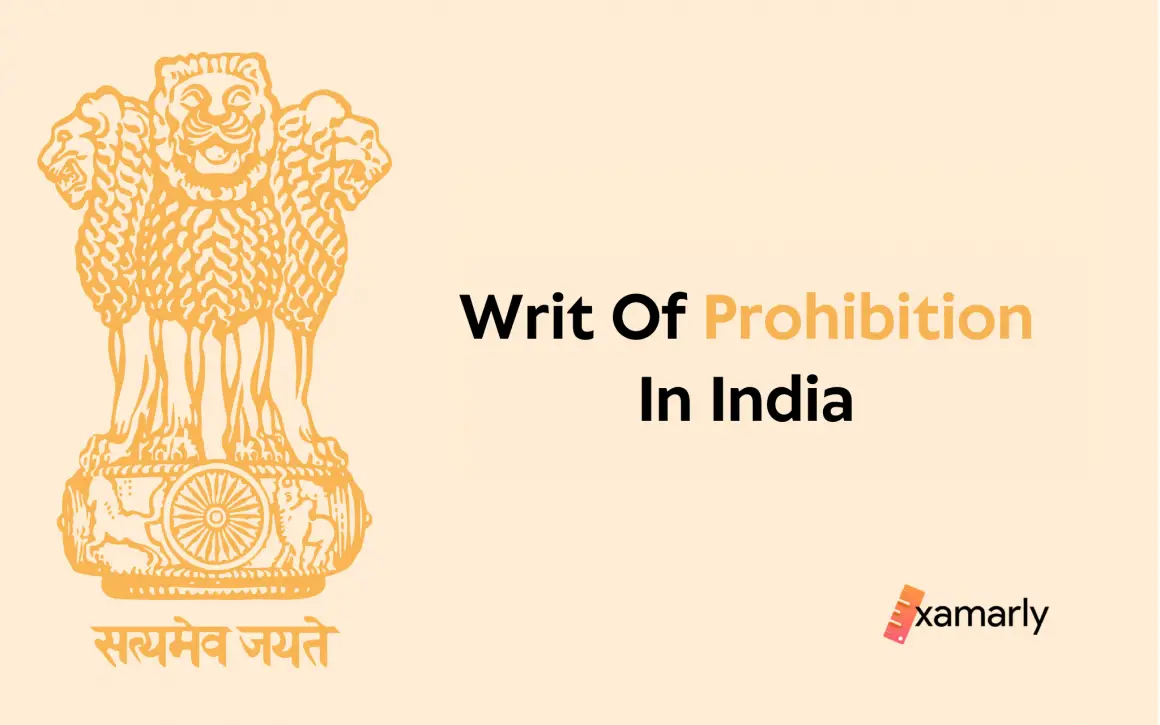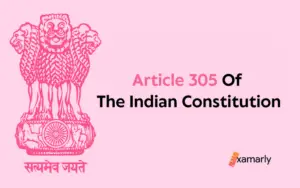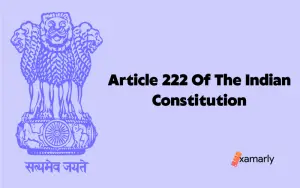The writ of prohibition in India is one of the 5 main Types Of Writs In India.
It revolves around checks on the powers of the lower courts by a higher court in the territory of India.
In this article, we’ll have a deeper understanding of the writ of prohibition in India.
- What Is The Writ Of Prohibition In India?
- History Of The Writ Of Prohibition In India
- Scope Of The Writ Of Prohibition In India
- Evolution Of The Writ Of Prohibition In India
- Writ Of Prohibition In India – Grounds Of Issuance
- How Is The Writ Of Prohibition In India Issued?
- Writ Of Prohibition In India – Who Can File A Petition?
- Writ Of Prohibition In India – Limitations
- Writ Of Prohibition In India – Landmark Judgements
- Writ Of Prohibition In Other Nations
- Differences Between Writ Of Prohibition In India & Writ Of Certiorari
- Summary
- FAQs Related To Writ Of Prohibition In India
- What is the purpose of a writ of prohibition in India?
- What are the conditions to be fulfilled for grant of writ of prohibition?
- What distinguishes a writ of certiorari from a writ of prohibition?
- Can a writ of prohibition be issued at any stage of the proceedings?
- Can a writ of prohibition be used to correct errors of fact or law made by a lower court or tribunal?
- Is the Writ of Prohibition discretionary or mandatory?
What Is The Writ Of Prohibition In India?
A writ of prohibition in India is a legal remedy that is used to prevent a lower court or tribunal from exceeding its jurisdiction or from proceeding with a case in an illegal or improper manner.
It cannot be issued to a private person/organisation.
This writ is issued by a higher court, such as the High Court or the Supreme Court, and is typically used to correct abuses of power by lower courts or to ensure that legal proceedings of the public office are conducted in accordance with the law.
It is one of several types of writs that are available under the Indian Constitution to provide relief to individuals who have been adversely affected by the actions of government officials or public office/bodies.
History Of The Writ Of Prohibition In India
The writ of prohibition in India has its origins in the English common law system, which was inherited by India during British colonial rule.
The power of higher courts like the Supreme Court or the High Court to issue writs for the enforcement of fundamental rights and for any other purpose is enshrined in Article 226 of the Indian Constitution, which was adopted in 1950.
The writ of prohibition, along with other types of writs such as the Writ Of Habeas Corpus and the Writ Of Mandamus, has been used in India as a means of ensuring that legal proceedings are conducted in accordance with the law and that the rights of individuals are protected.
In the early days after independence, the Indian courts have liberally used the writ jurisdiction to provide relief to the affected parties and to curb the excesses of the administrative authorities/public offices.
Over the years, the Indian judiciary has used the writ of prohibition to address a wide range of issues, including violations of fundamental rights, abuses of power by lower courts and tribunals, and illegal or improper proceedings.
The writ of prohibition in India has also been used to address issues related to the environment, land acquisition, and corruption.
It has played an important role in the development of Indian jurisprudence and in ensuring that the rights and interests of individuals are protected.
This writ continues to be an important tool for providing relief to individuals and organisations who have been adversely affected by the actions of public officials or public bodies and to correct any error of law.
Scope Of The Writ Of Prohibition In India
The scope of a writ of prohibition in India is quite broad, and it can be used to address a wide range of issues related to the jurisdiction and procedural fairness of lower courts and tribunals.
Some of the key areas where a writ of prohibition may be sought include:
- Excess of jurisdiction: If a lower court or tribunal is found to be exceeding its jurisdiction and acting beyond the powers granted to it by law, a writ of prohibition may be issued to prevent it from proceeding with the case.
- Lack of jurisdiction: If a lower court or tribunal is found to be lacking the necessary jurisdiction to hear a case, a writ of prohibition may be issued to prevent it from proceeding with the matter.
- Violation of natural justice: If a lower court or tribunal is found to be acting in a manner that is contrary to the principles of natural justice, such as by denying a party the right to a fair hearing or by ignoring relevant evidence, a writ of prohibition may be issued to prevent it from continuing with the case.
- Prejudice to a party: If a lower court or tribunal is found to be causing prejudice to a party, a writ of prohibition may be issued to prevent it from proceeding with the case.
- Improper exercise of discretion: If a lower court or tribunal is found to be improperly exercising discretion, a writ of prohibition may be issued to prevent it from proceeding with the case.
It’s important to note that a writ of prohibition in India cannot be used to correct errors of fact or law made by a lower court or tribunal.
Its scope is limited to preventing the lower court or tribunal from proceeding in a manner that is violative of jurisdiction or natural justice.
Evolution Of The Writ Of Prohibition In India
The writ of prohibition in India has its roots in the British common law system, which was inherited by India upon gaining independence.
The concept of writs as a means of judicial review was first introduced in India by the Indian High Courts Act of 1861, which granted the newly established High Courts the power to issue writs for the enforcement of fundamental rights and for the redress of grievances.
The writ of prohibition in India was specifically first used in the early 20th century by the High Courts to prevent lower courts and tribunals from exceeding their jurisdiction or acting in a manner that was contrary to the rules of natural justice.
Over time, the scope of the writ of prohibition has been expanded in India to include a wider range of issues related to jurisdiction and procedural fairness.
The Supreme Court of India has also played a major role in the evolution of the writ of prohibition in India.
The court has issued a number of landmark judgments that have clarified the scope and application of the writ, and it has used the writ to strike down laws and policies that are violative of fundamental rights.
In a nutshell, the writ of prohibition has evolved over the years in India to become an important tool for ensuring that justice is served fairly and impartially, and for checking the abuse of power by lower courts and tribunals.
Writ Of Prohibition In India – Grounds Of Issuance
The grounds for issuance of a writ of prohibition in India are outlined in Article 226 of the Indian Constitution, which provides for the power of High Court’s to issue writs for the enforcement of fundamental rights and for any other purpose.
Some of the common grounds for issuance of a writ of prohibition in India include:
- Excess of Jurisdiction: When a lower court or tribunal acts beyond its jurisdiction or exceeds the limits of its authority, a writ of prohibition may be issued to prevent it from continuing to do so.
- Lack of Jurisdiction: When a lower court or tribunal lacks the jurisdiction to hear a case, a writ of prohibition may be issued to prevent it from proceeding with the case.
- Illegal or Improper proceedings: A writ of prohibition may be issued to prevent a lower court or tribunal from proceeding with a case in an illegal or improper manner.
- Abusing of power: A writ of prohibition may be issued to prevent a lower court or tribunal from abusing its power or authority.
- Violation of fundamental rights: A writ of prohibition may be issued to prevent a lower court or tribunal from violating the fundamental rights of an individual.
How Is The Writ Of Prohibition In India Issued?
The process for issuing a writ petition/writ of prohibition in India typically involves the following steps:
- Filing of a writ petition: An individual or organisation seeking a writ of prohibition must file a petition or application with the appropriate higher court, such as the High Court or the Supreme Court.
- Service of notice: The higher court will then issue a notice to the lower court, tribunal or other authority against which the writ of prohibition is sought, requiring it to show cause why the writ should not be issued.
- Hearing of the case: After the notice is served, the higher court will conduct a hearing to consider the arguments of both sides and determine whether or not to issue the writ of prohibition.
- Issuance of the writ: If the higher court determines that the lower court, tribunal or other authority has exceeded its jurisdiction or is proceeding with a case in an illegal or improper manner, it may issue a writ of prohibition directing it to stop the proceedings.
- Compliance with the writ: Once the writ of prohibition is issued, the lower court, tribunal or other authority is required to comply with it and stop the proceedings in question.
It’s important to note that the writ of prohibition in India is discretionary in nature and it is for the court to decide whether or not to issue the writ depending on the facts and circumstances of each case.
Also, the time frame for the issuance of writ of prohibition varies from case to case and it also depends on the complexity of the case and the court’s backlog.
Writ Of Prohibition In India – Who Can File A Petition?
A petition for a writ of prohibition in India can be filed by anyone who is affected by the actions of a lower court, tribunal or other authority that has exceeded its jurisdiction or is proceeding with a case in an illegal/improper manner.
This can include individuals, organisations, or even the government.
Individuals: Any person whose fundamental rights are violated or whose rights are affected by the actions of a lower court, tribunal or other authority can file a petition for a writ of prohibition.
Organisations: A company, association, or any other organisation can also file a petition for a writ of prohibition if its rights or interests are affected by the actions of a lower court, tribunal or other authority.
Government: Even the government can file a petition for a writ of prohibition if the lower court, tribunal or other authority is acting in a manner that is illegal or contrary to public interest.
It’s important to note that in order to file a petition for a writ of prohibition in India, the petitioner must have a sufficient interest in the matter and should not have an alternative remedy available.
Also, the petition should be filed in a timely manner, as there are time limits for filing petitions for writs under the Indian Constitution.
Writ Of Prohibition In India – Limitations
There are certain writ limits to the use of this writ, including:
- It can only be directed towards courts and tribunals that have some form of legal authority, and not towards government agencies or individuals who are not part of the legal system.
- It cannot be used to review the merits of a case or to challenge the findings of a lower court or tribunal.
- It can only be issued if the lower court or tribunal is acting in excess of its jurisdiction or in violation of the law, and not simply because the petitioner disagrees with the decision.
- It is not a substitute for an appeal or revision, and cannot be used as a means of challenging a final decision of a lower court or tribunal.
- It can only be issued if there is no other remedy available to the petitioner.
- It can be issued only if the petitioner has no other efficacious remedy.
- It can be issued only if the lower court or tribunal has no jurisdiction over the matter in question.
Writ Of Prohibition In India – Landmark Judgements
There have been several landmark judgments related to the writ of prohibition in India that have helped to clarify the scope and application of the writ.
Some of the key judgments include:
- R.M.D. Chamarbaugwala v. Union of India (1957): This case established that the writ of prohibition can be used to prevent a lower court or tribunal from exceeding its jurisdiction or from acting in a manner that is contrary to the rules of natural justice.
- Suk Das v. Union Territory of Arunachal Pradesh (1986): This case clarified that the writ of prohibition can be used to prevent a lower court or tribunal from proceeding with a case in the absence of jurisdiction.
- State of Maharashtra v. Prabhakar Pandurang Kunte (1989): This case established that the writ of prohibition can be used to prevent a lower court or tribunal from acting in a manner that is violative of the principles of natural justice, such as by denying a party the right to a fair hearing.
- State of Gujarat v. Vora Fatesingh Ranchhodbhai (1990): This case established that the writ of prohibition can be used to prevent a lower court or tribunal from causing prejudice to a party.
- Indian Council for Enviro-Legal Action v. Union of India (1996): This case clarified that the writ of prohibition can be used to prevent a lower court or tribunal from improperly exercising discretion.
- State of Andhra Pradesh v. K. Satyanarayana (2009): This case established that the writ of prohibition can be used to prevent a lower court or tribunal from proceeding with a case in the absence of jurisdiction.
- Union of India v. R. Gandhi, President, Madras Bar Association (2010): This case clarified that the writ of prohibition can be used to prevent a lower court or tribunal from acting in a manner that is violative of the principles of natural justice, such as by denying a party the right to a fair hearing.
These are just a few examples, there are many other cases that have been heard by the Indian courts on the writ of prohibition in India, and have helped to shape and clarify the law in this area.
Writ Of Prohibition In Other Nations
The writ of prohibition is a legal remedy that is available in several common law jurisdictions around the world, including the United States, Canada, Australia, and New Zealand.
The specific scope and application of the writ may vary slightly from one jurisdiction to another, but generally, it serves a similar purpose of preventing a lower court or tribunal from exceeding its jurisdiction or from acting in a manner that is contrary to the rules of natural justice.
In the United States, the writ of prohibition is typically used to prevent a lower court from proceeding with a case that is outside of its jurisdiction, or to prevent it from violating the rights of a party.
It is usually issued by an appellate court to a lower court and directs the lower court to refrain from proceeding with a particular case or matter.
In Canada, the writ of prohibition can be issued by a superior court to a lower court or tribunal, directing it to refrain from proceeding with a case or matter that is outside of its jurisdiction or that is violative of natural justice.
In Australia & New Zealand, the writ of prohibition is typically used to prevent a lower court or tribunal from exceeding its jurisdiction or from acting in a manner that is contrary to the rules of natural justice.
It is issued by a superior court to a lower court or tribunal, directing it to refrain from proceeding with a particular case or matter.
In most of these countries writ of prohibition is considered as a discretionary remedy and its grant depends on the judge’s discretion.
Differences Between Writ Of Prohibition In India & Writ Of Certiorari
The writ of prohibition in India and the writ of certiorari are two separate legal remedies that serve different purposes.
A writ of prohibition in India is a legal tool that can be utilised to stop a court of lower rank or tribunal from going beyond its legal authority or from proceeding in a way that is against the principles of fair play.
It is issued by a higher court to a lower court or tribunal, directing the latter to refrain from proceeding with a particular case or matter.
A writ of certiorari, on the other hand, is a legal remedy that is used to quash or set aside a decision or order of a lower court or tribunal that is found to be illegal, ultra vires, or in violation of the principles of natural justice.
It is issued by a higher court to a lower court or tribunal, directing the latter to send up the records of the case for review.
The main difference between the writ of prohibition and the writ of certiorari is that the former is used to prevent a lower court or tribunal from proceeding with a case or matter, while the latter is used to correct an error or an illegal decision made by a lower court or tribunal.
Another key difference is that a writ of prohibition can be issued at any stage of the proceedings, while a writ of certiorari can only be issued after the decision or order has been made by the lower court or tribunal.
Additionally, the writ of prohibition is issued to prevent the lower court or tribunal from proceeding with the case, while the writ of certiorari is issued to quash the decision already taken by the lower court or tribunal.
Summary
The writ of prohibition in India was used to check the abuse of power by lower courts and tribunals and to ensure that justice was served fairly and impartially.
In recent years, the writ has been used to address issues such as the violation of human rights, the abuse of executive power, and the failure of public authorities to discharge their duties.
You Might Also Like To Read: Writ Of Certiorari In India.
FAQs Related To Writ Of Prohibition In India
What is the purpose of a writ of prohibition in India?
A writ of prohibition is a legal tool that can be utilised to stop a court of lower rank or tribunal from going beyond its legal authority or from proceeding in a way that is against the principles of fair play.
It is issued by a higher court to a lower court or tribunal, directing the latter to refrain from proceeding with a particular case or matter.
What are the conditions to be fulfilled for grant of writ of prohibition?
The conditions for grant of writ of prohibition include:
1) The lower court or tribunal must be exceeding its jurisdiction or acting in a manner that is contrary to the rules of natural justice.
2) The party seeking the writ must have no other remedy available.
3) The writ must be in the interest of justice.
What distinguishes a writ of certiorari from a writ of prohibition?
A writ of prohibition is used to prevent a lower court or tribunal from proceeding with a case or matter, while a writ of certiorari is used to quash or set aside a decision or order of a lower court or tribunal that is found to be illegal, ultra vires, or in violation of the principles of natural justice.
Can a writ of prohibition be issued at any stage of the proceedings?
Yes, a writ of prohibition can be issued at any stage of the proceedings, including before, during, or after the proceedings in the lower court or tribunal.
Can a writ of prohibition be used to correct errors of fact or law made by a lower court or tribunal?
No, a writ of prohibition cannot be used to correct errors of fact or law made by a lower court or tribunal.
Its scope is limited to preventing the lower court or tribunal from proceeding in a manner that is violative of jurisdiction or natural justice.
Is the Writ of Prohibition discretionary or mandatory?
In India, the writ of prohibition is considered as a discretionary remedy, its grant depends on the judge’s discretion.






